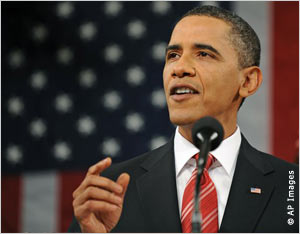2010-01-29 | Obama Bolsters Climate Commitments in State of the Union
Obama Bolsters Climate Commitments in State of the Union
29 01 2010

President Obama delivers his State of the Union address to Congress while Vice President Biden and House Speaker Nancy Pelosi applaud. (Photo: President Obama delivers his State of the Union address to Congress while Vice President Biden and House Speaker Nancy Pelosi applaud.)
By Carlyn Reichel
Staff Writer
Washington - In his first State of the Union address to Congress on January 27, President Obama reaffirmed his commitment to American leadership on climate change, touting innovation and clean-energy initiatives as crucial elements in America's economic recovery and in spurring job creation.
New energy technologies will be essential for remaining competitive in a 21st century global economy, Obama said, and American investment in this area should be a source of national pride. "Washington has been telling us to wait for decades, even as the problems have grown worse," Obama said. "Meanwhile, China is not waiting to revamp its economy. Germany is not waiting. India is not waiting. ... They're rebuilding their infrastructure. They're making serious investments in clean energy because they want those jobs."
Obama referenced 200,000 jobs in construction and clean energy that had been preserved or created through funding from the American Recovery and Reinvestment Act, a bill passed in February 2009 to spur economic growth. He encouraged lawmakers to consider legislation that would "put more Americans to work building clean-energy facilities and give rebates to Americans who make their homes more energy-efficient," activity that the president said supports clean-energy jobs.
CLIMATE LEGISLATION
"To create more of these clean-energy jobs," Obama said, "we need more production, more efficiency, more incentives." He called on the Senate to follow the House of Representatives and pass a comprehensive energy and climate bill "with incentives that will finally make clean energy the profitable kind of energy in America."
The House passed the American Clean Energy and Security Act in June 2009. It proposes to cut U.S. carbon dioxide emissions 17 percent from 2005 levels by 2020 and 83 percent by 2050. A similar bill has cleared the committee stage in the Senate, but has not yet been brought to the Senate floor for broader debate.
Since many lawmakers believe there are not enough Senate votes to pass the bill in its current form, Obama also signaled his openness for a bipartisan solution. He threw his support behind building new nuclear power plants and exploring new offshore drilling sites. Both options are often supported by Republicans, but are generally unpopular in the Democratic Party. Obama also called for increased investment in advanced biofuels and clean-coal technologies.
Obama said that, regardless of one's opinion on the causes of climate change, investing in clean-energy technologies will help Americans compete in a globalized economy.
"Even if you doubt the evidence [on climate change]," he said, "providing incentives for energy efficiency and clean energy are the right thing to do for our future - because the nation that leads the clean-energy economy will be the nation that leads the global economy. And America must be that nation."
NONCONGRESSIONAL ACTION
While Congress reviews potential legislative actions, the Obama administration has taken other important strides that do not require congressional involvement.
In December 2009, the Environmental Protection Agency (EPA) issued a finding under the Clean Air Act that greenhouse gases endanger public health and welfare. This endangerment finding authorizes the EPA to propose rules that ensure emitters use the best technology available to reduce their emissions. The EPA also is working with the U.S. Department of Transportation to enforce more stringent fuel-efficiency standards for new cars and trucks to help lower America's transportation emissions.
President Obama also signed an executive order requiring federal agencies to set reduction targets for their greenhouse gas emissions, increase their energy efficiency, and reduce their petroleum consumption.
The White House announced January 29 that the federal government will reduce its emissions 28 percent by 2020. "As the largest energy consumer in the United States, we have a responsibility to American citizens to reduce our energy use and become more efficient," President Obama said in the White House statement. "Our goal is to lower costs, reduce pollution, and shift federal energy expenses away from oil and towards local, clean energy."
On the international stage, President Obama said the United States has gone from being a "bystander to a leader in the fight against climate change." At the U.N. Climate Change Conference in Copenhagen (COP-15), the United States joined with other major economies to form a multilateral agreement to take transparent national action to curb domestic emissions and to support financing to help developing countries adapt. As part of the Copenhagen agreement, the United States announced its national emissions reduction target as 17 percent by 2020 on January 28, though the target remains contingent on congressional legislative action. (Read more about progress on the Copenhagen Accord.)